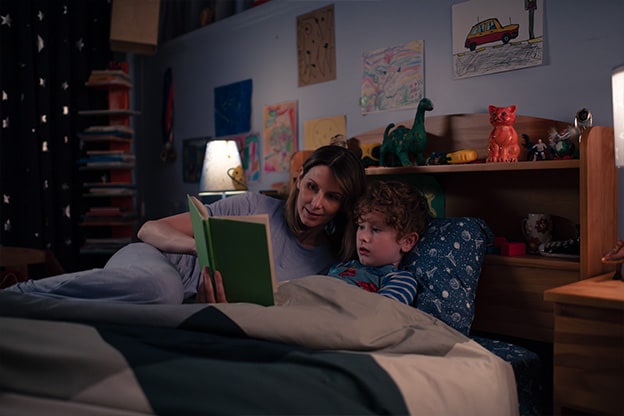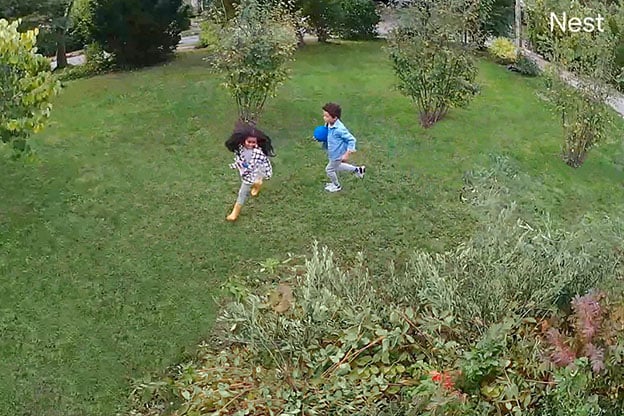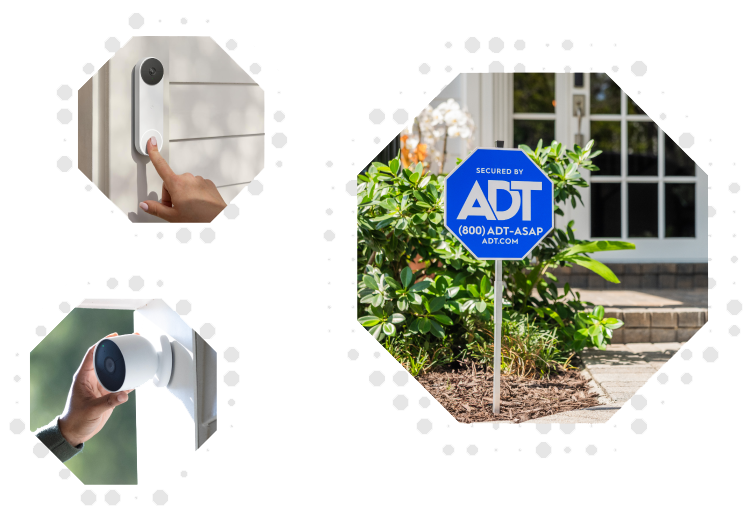Top 5 Security Tips for Families with Kids

Top 5 Security Tips for Families with Kids
Help protect the people who matter most with these practical, family-focused security tips.
Key Takeaways
- Secure doors, windows, and entry points with sensors and smart locks
- Set indoor safety zones and restrict access to hazardous areas
- Choose a security system with features tailored for families
- Use cameras and lighting to monitor outdoor play areas
- Teach kids safety basics based on their age and maturity
Raising a family comes with countless joys—and just as many responsibilities. One of the most important is ensuring your home is a safe, secure place where kids can grow, play, and thrive. From the front door to the backyard, every part of your home plays a role in protecting your family.
As technology evolves and security options expand, so do the opportunities to take smarter, more proactive steps. Whether you're a new parent babyproofing the nursery or guiding teens toward digital safety, thoughtful home security can provide peace of mind through every stage of family life.
In this article, we’ll share five essential security tips specifically for families with kids. These tips combine professional recommendations with practical ideas you can implement right away—so you can focus more on enjoying time together, and less on worrying about the what-ifs.


Secure Doors, Windows, and Entry Points
The most common entry points for intruders are often the same ones your family uses every day—doors, windows, and garage access. For families with children, securing these areas isn't just about preventing break-ins. It's also about protecting curious kids from wandering outside unsupervised.
Reinforce Vulnerable Areas
Start by making sure all exterior doors are equipped with strong, high-quality deadbolts. Reinforce door frames with strike plates and consider smart locks that provide keyless access and real-time notifications. Windows—especially those on the ground floor—should have secure locks, and window stops can prevent them from opening too wide.
Child-Proof with Safety in Mind
Think beyond traditional locks. Install secondary latches or sensors that alert you when a door or window is opened—particularly helpful if you have toddlers or young children who like to explore. For sliding doors or basement entries, use security bars or auxiliary locks to add another layer of protection.
Build Safe Habits Into Daily Routines
Security starts with consistency. Make it part of your family’s routine to check that all doors and windows are locked each night. If your kids are old enough, teach them not to open the door for strangers, even if someone seems friendly. Reinforce the idea that security is a shared responsibility, tailored to each child’s age and understanding.
Create Safe Zones Inside the Home
A secure home isn't just about keeping the outside world out—it's also about making the inside safer for your kids. From everyday play to unexpected emergencies, creating safe zones throughout your home helps reduce risks and supports better awareness for the entire family.
Set Digital Boundaries
As smart devices become more common in homes, it’s important to control who can access them. Use parental controls and secure login settings on apps that manage your security system, smart locks, or surveillance footage. Only trusted adults should have full access, while children can be introduced to features like doorbell cameras or intercoms as appropriate for their age.
Designate “Off-Limits” Areas
Rooms like garages, laundry rooms, kitchens, and home offices often contain hazards—from cleaning products and tools to internet-connected devices. Use childproof locks, cabinet latches, and interior door sensors to secure these areas. Gates can also be helpful for restricting access to staircases or storage rooms.
Establish an Emergency Plan
Make sure every member of the family knows what to do in case of a fire, break-in, or weather-related emergency. Identify primary and secondary exits, and practice escape routes periodically. Store emergency supplies in an easy-to-reach location and teach older kids how to safely call for help, even if they’re home alone.


Common Home Security Concerns for Parents (and How to Solve Them)
Even the most attentive families face challenges when it comes to keeping kids safe at home. From toddlers opening doors to teens forgetting to arm the system, it helps to know you're not alone—and that there are simple solutions. Here are a few common concerns and what you can do about them:
| Concern | Why It Matters | Simple Fix |
|---|---|---|
| Toddler opens front door | Risk of wandering | Add door sensor with chime |
| Teen forgets to arm the system | Weakens home security | Use app alerts or auto-arming features |
| Backyard access at night | Poor visibility | Install motion lights + outdoor camera |
| Kids answer door for strangers | Personal safety risk | Teach 'don’t open door' rule + use video |


Install a Home Security System with Family in Mind
A security system is one of the most effective ways to help protect your home—but not all systems are created with families in mind. When choosing one, it’s important to look beyond basic features and consider how the system can support the specific needs of a household with children.
You’ll want a system that balances safety, simplicity, and flexibility. The right setup can help you stay connected to your home when you’re away, give kids age-appropriate independence, and add peace of mind without adding complexity.
What to Look for in a Family-Friendly System
The following features are especially helpful for families with children:
- Custom user codes: Let each family member (or trusted caregiver) have their own code, so you know who’s coming and going.
- Remote access and mobile alerts: Get real-time notifications if a door is opened or a motion sensor is triggered while you're away.
- Panic buttons and voice integration: These features allow for quick action in case of emergency—whether by pressing a discreet button or using a voice assistant.
- Indoor cameras and two-way audio: Keep an eye on what’s happening in common areas, and check in with kids after school or during a babysitter’s visit.
These features can make a big difference in helping families stay connected and protected—especially when paired with a system built for modern households.
Explore ADT’s smart home security options to see what might be the right fit for your family.
Getting Kids Involved Safely
As your children get older, teach them how to use basic features of the system—like arming it when they leave or disarming it when they get home. Keep things simple and age-appropriate. For younger children, focus on awareness rather than responsibility.
Pro Tip: Use practice mode or demo settings (if available) to teach kids what alarms sound like and what steps to take in case one goes off.
With the launch of the ADT+ smart home security platform in 2024, families now benefit from integrated professional monitoring, AI-powered alerts, and seamless control via the ADT+ app. These enhancements simplify daily safety routines and improve response reliability when it counts most.
Monitor Outdoor Spaces Where Kids Play
Backyards, driveways, porches, and side yards often serve as play zones or hangout spots for kids—but these areas can also be among the most overlooked when it comes to home security. Keeping an eye on outdoor spaces not only helps deter intruders, but also allows parents to watch over kids while giving them room to explore and play safely.
Outdoor Security Tips for Family Homes
The following tips can help you better monitor and secure the outdoor areas where children spend time:
- Install cameras with wide-angle views: Look for models that offer live video feeds, night vision, and motion detection to cover large areas like yards, patios, and driveways.
- Use motion-activated lighting: These not only alert you to movement, but can also discourage trespassing or late-night exploring by kids.
- Secure gates and fences: Ensure backyard gates have reliable locks or sensors, and check fences regularly for damage or weak spots.
- Keep sheds and garages locked: These spaces often contain tools, chemicals, or sharp objects that could be dangerous for children.
Add Visibility, Not Just Security
Outdoor monitoring isn’t just about keeping threats out—it’s also about peace of mind. Whether your kids are building forts, riding bikes, or playing tag, knowing you can check in from your phone or tablet adds a reassuring layer of oversight.
If you have a pool or water feature, consider adding sensors or cameras with alert settings specific to those zones. Even small additions like this can make a big difference in preventing accidents.
Quick-Check: Family Security To-Do List
Want a fast way to assess your home’s safety setup? Use this checklist to see how many of these family-friendly security habits and tools you already have in place—or compare it against a seasonal security checklist for added coverage year-round:
Empower Kids with Age-Appropriate Safety Education
Even the most advanced security setup can only go so far without one essential component: awareness. Teaching kids how to stay safe—both at home and online—is just as important as installing locks or cameras. When children understand their role in family safety, they become active participants in protecting themselves and others.
Build Safety Confidence Early
Start with the basics: knowing their full name, address, and how to dial 911. As kids grow, expand the conversation to include emergency response, identifying safe adults, and understanding what to do if they feel unsafe—even at home. Repetition and age-appropriate role-playing can go a long way in helping these lessons stick.
Smart Security Lessons for Different Ages
Every child matures at their own pace, but here’s a general guide to what you might introduce at various stages:
- Ages 3–5: Focus on simple rules like not opening the door, staying close to caregivers, and recognizing household alarms or alert sounds.
- Ages 6–9: Teach them how to safely use a home phone or smart speaker to call for help. Show them which adults are safe to talk to and introduce the concept of emergency exits.
- Ages 10–13: Introduce basic system interactions—like using a keypad or understanding mobile alerts (without full access). Reinforce digital safety habits.
- Teens: As they become more independent, help them understand system settings, permissions, and how to responsibly manage access when home alone or with friends.
Pro tip: Schedule a family safety check-in every few months. Walk through escape routes, test alarms, and revisit roles and rules as kids grow and routines change.
FAQs
What’s the best type of security system for a family with kids?
There’s no one-size-fits-all solution, but look for systems that offer mobile access, multiple user codes, panic buttons, and sensors for doors and windows. Systems with flexible controls and easy-to-understand interfaces are ideal for families.
At what age should kids learn about home security?
It’s never too early to start teaching basic safety concepts. For toddlers and preschoolers, that means learning not to open doors or windows. As kids get older, you can introduce more specific system features and emergency response steps.
How can I keep my home secure without making my kids feel scared?
The goal is empowerment, not fear. Use age-appropriate language and explain that safety tools (like alarms or cameras) are there to help protect the family. Framing it as a way to be prepared, not paranoid, can make kids feel more secure—not anxious.
Are outdoor cameras necessary if I already have a doorbell camera?
A doorbell camera is a great start, but it often only covers the front door. If your children play in the backyard or driveway, additional cameras can give you broader visibility and real-time reassurance when they’re outside.
What’s the safest way to let kids come home alone after school?
If your children are old enough to stay home briefly on their own, consider using smart locks, indoor cameras, and app alerts to monitor arrivals. Always review rules and check-ins together ahead of time.
Final Thoughts
Protecting your home is about more than just technology—it’s about creating a safe, confident environment for the people you love most. With the right combination of tools, habits, and education, families can feel secure without feeling overwhelmed.
By taking proactive steps to secure entry points, create safe zones, involve your kids, and monitor key areas, you’ll be building not just a safer home—but a smarter one, too. Whether you're just starting your family or navigating the teen years, these security tips can grow with you, offering peace of mind at every stage.
Want added peace of mind in the moments that matter most? ADT offers professionally monitored security solutions that help protect your home and support fast response when it counts. With 24/7 monitoring, smart alerts, and flexible options for any lifestyle, you can feel more confident whether you're home or away.
About the author


Gabe Turner
Gabe Turner is an attorney and journalist who has spent years at the forefront of safety and technology. As the founder of one of the most influential online resources in the home security space, he has tested hundreds of products and guided consumers through complex choices. Today, he lends his expertise to help readers make confident, informed decisions about protecting what matters most.




